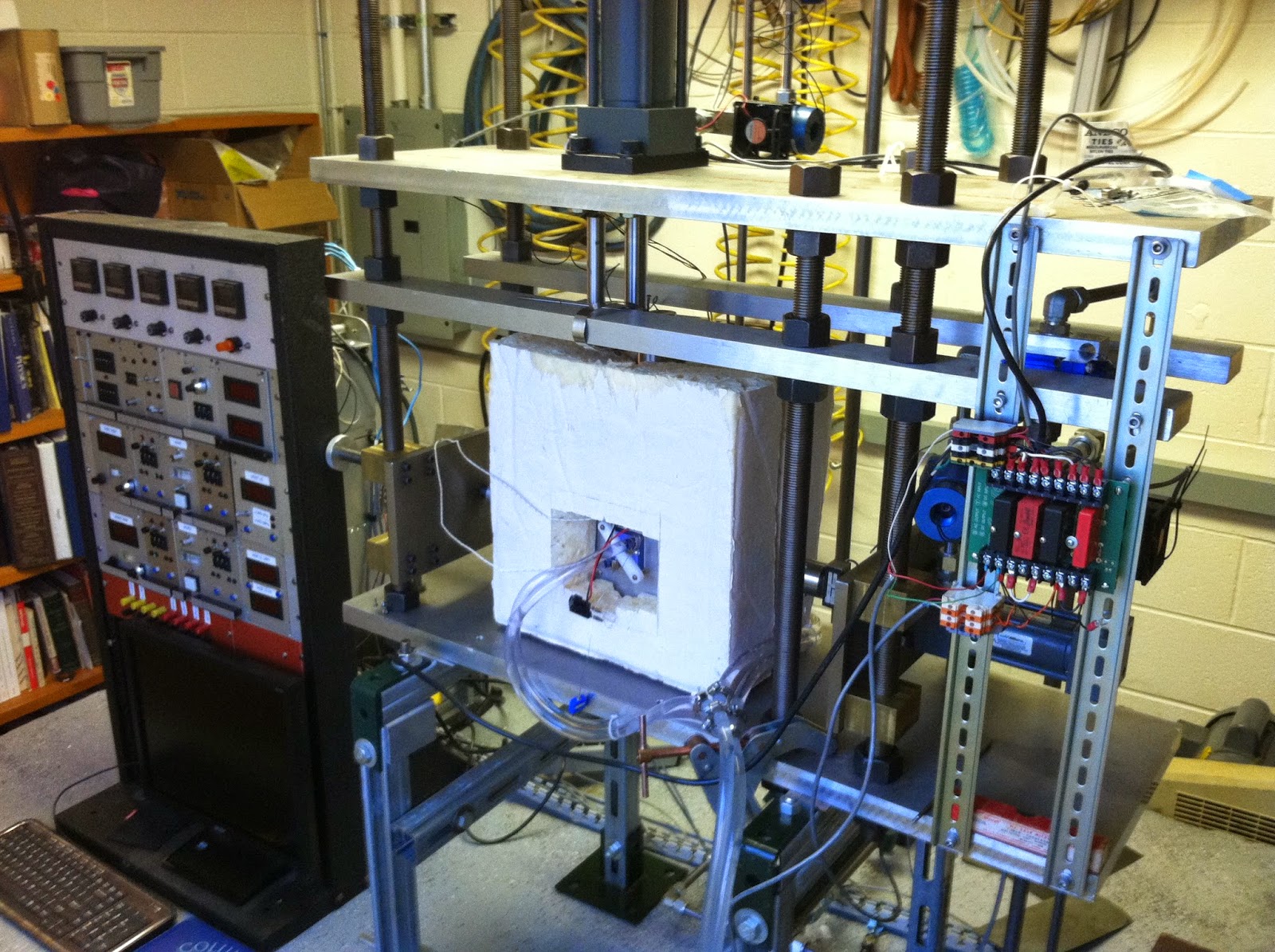Huge progress in the lab today. The last month or two have been filled with a whole lot of calibrating, adjusting, wiring….
…testing, cross testing and multi component cross testing. Ted has been working his butt off getting all the electronics to talk to each other just right, getting all the limits and failsafes to do their job, and fixing last minute hydraulic leaks.
And this afternoon, we had the load cells and LVDTs hooked up and the electronics driving the hydraulics pistons. We can make it move up and down on command, in either load or position control. This is huge! THE LDEO CRY-AX IS ALIVE! We can now start squeezing and sliding the heck out of stuff! Yeah!
text
The rock and ice mechanics lab at Lamont-Doherty is led by PIs Christine McCarthy and Ben Holtzman. Now, more than ever, we are in the process of growing our lab and building our experimental program. Along with a team of postdocs, undergrads, grads, techs, and longtime staff engineer Ted, we are rehabilitating and revamping some of the old equipment and building and buying new rigs for exciting new experiments on both rock and ice. You can follow along with our progress here.
Thursday, 19 February 2015
adventures in standard ice
One of the important parts of any laboratory study is the preparation of samples. Currently we are focusing on the fabrication of rectangular polycrystalline ice samples that we will use in the ice friction experiments. Mike will also be using them in his senior thesis project. He will expose the samples of so-called "standard ice" to various temperature pulses and characterize how they respond. Scientists over the last few decades have perfected a method for making standard ice, although in all the previous cases they made cylinders, so we are doing something a little new. I previously reported on the rectangular die that we built. Well that has gone through a few changes, including a gasketed top that screws down to prevent leakage at the top. Plus, silicone sealant has been placed at all the seams and long risers were put on the top ports…
…so that we didn't have to get our hands wet opening valves while the die and large flask were submerged in the bath.
The idea with the standard ice is that you have packed "seed ice" and liquid water both equilibrated in a big tub of ice water, getting the whole system down to exactly zero degrees C. Then you pull a vacuum on the seed ice and open the valve to the inverted flask. The cold water floods the pore space of the seed ice. You then quickly put the flooded die in the cold room (-30C) atop a copper plate and insulate the sides, promoting bottom up directional freezing of the water you introduced. The process, we found, takes a couple of hours (not counting the making of the seed ice, which I'll report on later. That's a whole other can of worms) but then you are left with this giant bucket of ice water to throw away. Seemed wasteful. So we downsized the whole shebang to this much smaller bucket, lowered the risers, and swapped out the huge inverted flask for a small squirt bottle.
…so that we didn't have to get our hands wet opening valves while the die and large flask were submerged in the bath.
The idea with the standard ice is that you have packed "seed ice" and liquid water both equilibrated in a big tub of ice water, getting the whole system down to exactly zero degrees C. Then you pull a vacuum on the seed ice and open the valve to the inverted flask. The cold water floods the pore space of the seed ice. You then quickly put the flooded die in the cold room (-30C) atop a copper plate and insulate the sides, promoting bottom up directional freezing of the water you introduced. The process, we found, takes a couple of hours (not counting the making of the seed ice, which I'll report on later. That's a whole other can of worms) but then you are left with this giant bucket of ice water to throw away. Seemed wasteful. So we downsized the whole shebang to this much smaller bucket, lowered the risers, and swapped out the huge inverted flask for a small squirt bottle.
The result is this fully dense rectangle of crystalline ice. Here Mike is taking a slice with a wood saw so that we can take a closer look and see how we did.
He'll be imaging the samples with the microscope we have in the cold room and then analyzing the images for things like grain growth, porosity, fracturing, etc. Take special note of what he's wearing. After one day in the cold room, he knew there had to be a better way. He came back the next day with an old plastic hazmat suit that he'd rigged up with a blowdryer to make this custom warm suit. I've got an order in for a second!
Subscribe to:
Posts (Atom)







